The Healthcare sector ranks third out of the ten sectors as detailed in my sector roadmap. It gets my Neutral rating, which is based on aggregation of the ratings of 22 ETFs and 83 mutual funds in the Healthcare sector as of July 11, 2012.
Figures 1 and 2 show the five best and worst-rated ETFs and mutual funds in the sector. Not all Healthcare sector ETFs and mutual funds are created the same. The number of holdings varies widely (from 20 to 296), which creates drastically different investment implications and ratings. The best ETFs and mutual funds allocate more value to Attractive-or-better-rated stocks than the worst ETFs and mutual funds, which allocate too much value to Neutral-or-worse-rated stocks.
To identify the best and avoid the worst ETFs and mutual funds within the Healthcare sector, investors need a predictive rating based on (1) stocks ratings of the holdings and (2) the all-in expenses of each ETF and mutual fund.
Investors seeking exposure to the Healthcare sector should buy one of the Attractive-or-better rated ETFs or mutual funds from Figures 1 and 2.
Figure 1: ETFs with the Best & Worst Ratings – Top 5
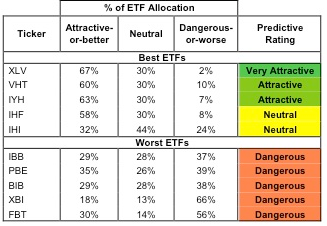
* Best ETFs exclude ETFs with TNA’s less than 100 million for inadequate liquidity.
Sources: New Constructs, LLC and company filings
Focus Morningstar Healthcare Index ETF (FHC) is excluded from Figure 1 because its total net assets (TNA) are below $100 million and do not meet our liquidity standards.
Figure 2: Mutual Funds with the Best & Worst Ratings – Top 5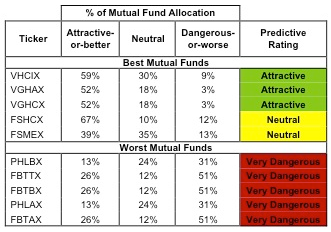
* Best mutual funds exclude funds with TNA’s less than 100 million for inadequate liquidity.
Sources: New Constructs, LLC and company filings
8 mutual funds are excluded from Figure 2 because their total net assets (TNA) are below $100 million and do not meet our liquidity standards.
Healthcare Select Sector SPDR (XLV) is my top-rated Healthcare ETF and Vanguard World Funds: Vanguard Healthcare Index Fund (VHCIX) is my top-rated Healthcare mutual fund. XLV earns my Very Attractive rating and VHCIX earns my Attractive rating.
First Trust NYSE Arca Biotechnology Index Fund (FBT) is my worst-rated Healthcare ETF and Fidelity Advisor Series VII: Fidelity Advisor Biotechnology Fund (FBTAX) is my worst-rated Healthcare mutual fund. FBT earns my Dangerous rating and FBTAX earns my Very Dangerous rating.
Figure 3 shows that 83 out of the 344 stocks (over 56% of the total net assets) held by Healthcare ETFs and mutual funds get an Attractive-or-better rating. However, only 4 out of 22 Healthcare ETFs (over 50% of total net assets) and 8 out of 83 Healthcare mutual funds (over 56% of total net assets) get an Attractive-or-better rating.
The takeaway is: the vast majority ETFs and mutual fund managers (81% of Healthcare ETFs and 90% of Healthcare mutual funds) allocate too much capital to low-quality stocks.
Investors, however, have successfully identified Attractive-or-better rated ETFs and mutual funds that hold great stocks and charge low fees. Figure 3 shows that 50% of the total net assets in Healthcare ETFs and 56% of total net assets in Healthcare mutual funds are allocated to the 4 ETFs and 8 mutual funds that earn an Attractive-or-better rating.
Figure 3: Healthcare Sector Landscape For ETFs, Mutual Funds & Stocks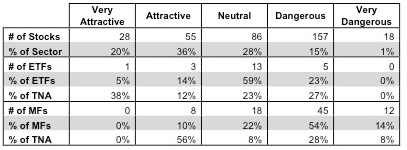
Sources: New Constructs, LLC and company filings
As detailed in “Cheap Funds Dupe Investors”, the fund industry offers many cheap funds but very few funds with high-quality stocks, or with what I call good portfolio management.
Investors need to tread carefully when considering Healthcare ETFs and mutual funds, because 81% of the ETFs and 90% of the mutual funds are rated Neutral-or-worse, with 68% of mutual funds getting a Dangerous or Very Dangerous rating. Only 4 ETFs and 8 mutual funds in the Healthcare sector (19% of ETFs and 10% of mutual funds) allocate enough capital to Attractive-or-better-rated stocks in order to earn an Attractive rating.
AmerisourceBergen Corporation (ABC) is one of my favorite stocks held by Healthcare ETFs and mutual funds and earns my Very Attractive rating. AmerisourceBergen has shown consistent NOPAT growth over the last 5+ years with rising Economic Earnings and an ROIC of 15.5% in the most recent year. The company is highly profitable, but the current stock price implies that AmerisourceBergen’s profits will permanently decline by 21%. The mix of consistent economic profitability and a price that implies low expectations going forward offers an attractive risk/reward trade-off for investors.
MedAssets Inc. (MDAS) is one of my least favorite stocks held by Healthcare ETFs and mutual funds and earns my Very Dangerous rating. For the past three years, MedAssets has earned an ROIC below its WACC, which means the returns the company generates on the capital that has been invested in the business are not sufficient to create value for shareholders. Not only has MedAssets been a poor steward of shareholder capital, its current stock price implies dramatic improvement. In order to justify today’s price, the company would need to grow revenues at over 18% compounded annually for the next 20 years. Those are expectations that few companies could ever meet. The stock price’s implied high expectations, coupled with the consistent failure to create value for shareholders, means that this is a Very Dangerous stock to own.
Figures 4 and 5 show the rating landscape of all Healthcare ETFs and mutual funds.
Figure 4: Separating the Best ETFs From the Worst ETFs 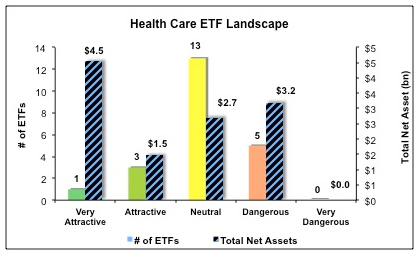
Sources: New Constructs, LLC and company filings
Figure 5: Separating the Best Mutual Funds From the Worst Mutual Funds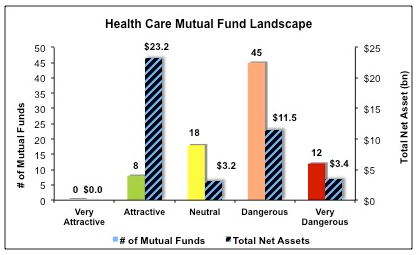
Sources: New Constructs, LLC and company filings
Disclosure: I receive no compensation to write about any specific stock, sector or theme.
- English (UK)
- English (India)
- English (Canada)
- English (Australia)
- English (South Africa)
- English (Philippines)
- English (Nigeria)
- Deutsch
- Español (España)
- Español (México)
- Français
- Italiano
- Nederlands
- Português (Portugal)
- Polski
- Português (Brasil)
- Русский
- Türkçe
- العربية
- Ελληνικά
- Svenska
- Suomi
- עברית
- 日本語
- 한국어
- 简体中文
- 繁體中文
- Bahasa Indonesia
- Bahasa Melayu
- ไทย
- Tiếng Việt
- हिंदी
Best And Worst ETFs (And Mutual Funds): Healthcare Sector
Published 07/15/2012, 01:32 AM
Updated 07/09/2023, 06:31 AM
Best And Worst ETFs (And Mutual Funds): Healthcare Sector
Latest comments
Loading next article…
Install Our App
Risk Disclosure: Trading in financial instruments and/or cryptocurrencies involves high risks including the risk of losing some, or all, of your investment amount, and may not be suitable for all investors. Prices of cryptocurrencies are extremely volatile and may be affected by external factors such as financial, regulatory or political events. Trading on margin increases the financial risks.
Before deciding to trade in financial instrument or cryptocurrencies you should be fully informed of the risks and costs associated with trading the financial markets, carefully consider your investment objectives, level of experience, and risk appetite, and seek professional advice where needed.
Fusion Media would like to remind you that the data contained in this website is not necessarily real-time nor accurate. The data and prices on the website are not necessarily provided by any market or exchange, but may be provided by market makers, and so prices may not be accurate and may differ from the actual price at any given market, meaning prices are indicative and not appropriate for trading purposes. Fusion Media and any provider of the data contained in this website will not accept liability for any loss or damage as a result of your trading, or your reliance on the information contained within this website.
It is prohibited to use, store, reproduce, display, modify, transmit or distribute the data contained in this website without the explicit prior written permission of Fusion Media and/or the data provider. All intellectual property rights are reserved by the providers and/or the exchange providing the data contained in this website.
Fusion Media may be compensated by the advertisers that appear on the website, based on your interaction with the advertisements or advertisers.
Before deciding to trade in financial instrument or cryptocurrencies you should be fully informed of the risks and costs associated with trading the financial markets, carefully consider your investment objectives, level of experience, and risk appetite, and seek professional advice where needed.
Fusion Media would like to remind you that the data contained in this website is not necessarily real-time nor accurate. The data and prices on the website are not necessarily provided by any market or exchange, but may be provided by market makers, and so prices may not be accurate and may differ from the actual price at any given market, meaning prices are indicative and not appropriate for trading purposes. Fusion Media and any provider of the data contained in this website will not accept liability for any loss or damage as a result of your trading, or your reliance on the information contained within this website.
It is prohibited to use, store, reproduce, display, modify, transmit or distribute the data contained in this website without the explicit prior written permission of Fusion Media and/or the data provider. All intellectual property rights are reserved by the providers and/or the exchange providing the data contained in this website.
Fusion Media may be compensated by the advertisers that appear on the website, based on your interaction with the advertisements or advertisers.
© 2007-2025 - Fusion Media Limited. All Rights Reserved.
